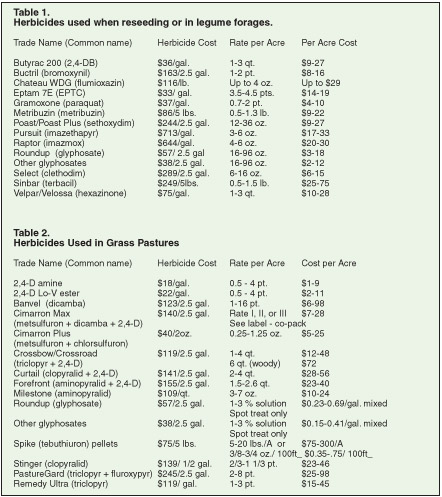It won’t be long until forages start to grow again for our 2012 production.
Last year’s wet growing season seemed to encourage growth of weeds many producer’s had not seen in their fields before. Did you have problems with undesirable weeds? Are you planning to take steps to control any of those weeds this year?
Managing weeds in pastures and hay fields requires a different approach than weed management in row crops.
The Ohio State University Extension Weed Control Guide suggests the best way to control weeds in established stands of alfalfa is to maintain a dense healthy forage stand through proper fertilization, cutting management, and insect control. More than 95 percent of the weeds can be controlled through good management practices.
Can crowd forages
Weeds can become a problem however, if they interfere with light penetration to the forage plant leaves, use excessive nutrients intended for the forage plants, or take water or growing space from the forage plants. This can directly influence the yield and length of time a field remains highly productive.
For example, alfalfa stands have been reported to lose up to 30 percent of the stand from infestations of common chickweed. If chickweed emerges through the fall and into spring, it develops a thick lush mat that competes strongly with the alfalfa until first cutting hay is made.
Purple deadnettle and henbit can cause the same problem.
If these weeds persist and then die, summer annual weeds like henbit, lambsquarters, pigweed or others often take over.
Perennial weeds such as dandelion can also creep into portions of the growing area to reduce yields and/or quality even further.
Before you spray…
In most cases, herbicides can be used to eliminate the weed pressure in alfalfa if you choose to do so. But, before using herbicides, one should evaluate the existing stand to be sure it is worth the cost of the herbicide and the amount to apply the treatment.
Reseeding may be more cost effective. When weeds invade mixed grass/legume stands it poses a little different problem than pure stands because management strategies are limited that remove broadleaf weeds without killing your legumes.
Grazing management and harvest management can provide help here also if you do not allow weeds to produce seed heads, but this is extremely hard to accomplish.
Money well spent
Good soil fertility and maintaining soil pH of 6.5-7 helps forage plants vigorously compete against weeds.
Spending money to provide good fertility may be the best and most cost effective means to reduce weed pressure in mixed grass/legume stands.
Grass pastures. Grass pastures are another place weeds can cause producers problems. There are some invasives, such as spotted knapweed (Ohio’s newest pasture invader) and woody stemmed plants that try to take over pastures leaving produces few alternatives but to use herbicides.
Quick recognition and prompt action to control these invaders is important. It will save you a lot of headaches later, so be aware and monitor your fields regularly.
In the 2012 Ohio Weed Control Guide (link opens 196-page .pdf), bulletin 789, table 20, page 150, the authors rate the effectiveness of herbicides on a variety of weeds in legumes and grass pasture forage stands.
This publication provides a wealth of information and each livestock producer should read the forage production section.
Spraying costs
To estimate the cost of applying herbicides, I’ve included several common products.
Table 1. lists herbicides used to control weeds in legumes or when reseeding and estimates the cost of the chemical per acre.
Table 2. compares common herbicides used in grass pastures for weed and brush control.
(Column continues below chart.)
The prices and container size available in your area may vary, from information I used, but at least we can make some comparisons and you can insert your purchase costs if you choose too. Cost per acre, or square foot was calculated using the range of recommended rates listed on the labels. There are different formulations of many of these herbicides so be sure to read the label before purchasing and or making any applications.
Spring is less than a month away. Will you be ready?













